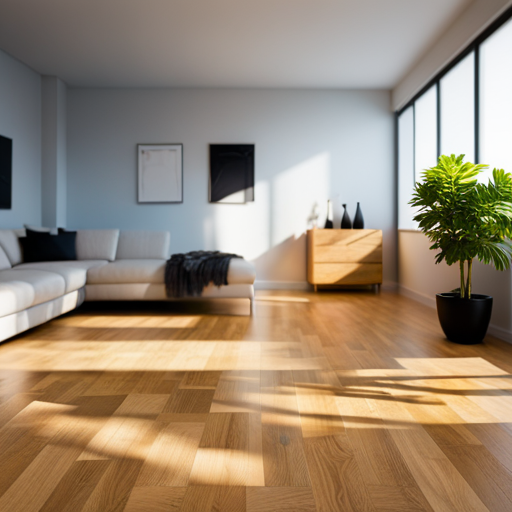The Impact of Flooring on Indoor Air Quality

Just as the foundation of a house provides stability, the flooring within it plays a crucial role in maintaining indoor air quality.
This article delves into the impact of flooring materials on the air we breathe, offering an objective analysis of their allergen trapping abilities, VOC emissions, and maintenance implications.
By examining evidence-based recommendations, readers can make informed choices to enhance indoor air quality and create healthier living environments.
Common Flooring Materials and Their Air Quality Impact
Several common flooring materials can impact indoor air quality significantly. The choice of flooring materials can have implications for indoor air quality and, consequently, human health. For instance, carpets can harbor dust, pet dander, and other allergens, contributing to poor indoor air quality and potential health effects such as allergies and respiratory issues. Additionally, certain adhesives, sealants, and finishes used in flooring installation can emit volatile organic compounds (VOCs), which can degrade indoor air quality and pose health risks.
On the other hand, hard flooring materials such as hardwood, tile, or linoleum generally have lower potential to trap allergens and can be easier to clean, thus potentially improving indoor air quality. However, it’s essential to note that the impact of flooring materials on indoor air quality can vary based on factors such as maintenance, ventilation, and the presence of underlying issues like mold or moisture.
Understanding the relationship between flooring materials and indoor air quality is crucial for making informed decisions about flooring choices in different indoor environments. This connection sets the stage for examining allergen trapping and flooring choices to further understand their impact on indoor air quality.
Allergen Trapping and Flooring Choices
The presence of allergens in indoor environments can be influenced by the choice of flooring materials, impacting indoor air quality and human health. When considering flooring choices, it’s essential to understand their impact on allergen trapping and indoor air quality. The following points highlight the emotional impact of flooring choices:
-
Health Concerns: Allergens trapped in carpet fibers can exacerbate respiratory issues, causing discomfort and health concerns for individuals, particularly children and those with allergies or asthma.
-
Peace of Mind: Opting for flooring materials that are easy to clean and maintain can provide peace of mind, reducing the constant worry about allergens accumulating in the indoor environment.
-
Long-term Well-being: Choosing durable and eco-friendly flooring options not only improves indoor air quality by minimizing allergen trapping but also contributes to long-term well-being and environmental sustainability.
Considering flooring durability and eco-friendly options can significantly impact indoor air quality and human health, making informed choices essential for overall well-being. Understanding the impact of flooring materials on allergen trapping is crucial for creating healthier indoor environments. This understanding also extends to comprehending the emissions of volatile organic compounds (VOCs) from flooring materials.
Understanding VOC Emissions From Flooring
Understanding Flooring’s VOC Emissions
Volatile Organic Compounds (VOCs) are emitted as gases from certain solids or liquids and can have adverse health effects. Flooring materials, such as adhesives, sealants, and carpets, are known sources of VOC emissions. Exposure to high levels of VOCs can cause short-term health problems such as eye, nose, and throat irritation, headaches, and dizziness. Long-term exposure to VOCs has been linked to an increased risk of asthma, allergies, and even more serious health conditions. Thus, understanding emissions from flooring is crucial for maintaining indoor air quality.
To address the health implications associated with VOC emissions, it is essential to focus on VOC reduction strategies. Utilizing sustainable flooring alternatives, such as cork, bamboo, or linoleum, can significantly minimize VOC emissions, thereby promoting better indoor air quality. Additionally, selecting low-VOC adhesives and sealants and ensuring proper ventilation during and after flooring installation are important steps in reducing VOC emissions.
Best Flooring Options for Improved Indoor Air Quality
When considering the best flooring options for improved indoor air quality, the debate between hardwood and carpet arises.
Hardwood floors are often preferred due to their low VOC emissions and ease of cleaning.
Carpeting, on the other hand, can harbor allergens and trap dust and other particles.
Additionally, cork flooring is gaining attention for its natural properties that resist mold, mildew, and pests.
This makes it a beneficial choice for those seeking to improve indoor air quality.
Hardwood Vs. Carpet
Comparison between hardwood and carpet reveals significant differences in their impact on indoor air quality, making it crucial to consider the best flooring option for improved air quality.
-
Maintenance Comparison
-
Hardwood floors are easier to clean and maintain compared to carpets, which can trap dust, allergens, and pet dander, requiring regular vacuuming and deep cleaning to prevent indoor air pollution.
-
Indoor Temperature Regulation
-
Hardwood floors are better at conducting heat, making them ideal for promoting even indoor temperature regulation. In contrast, carpets can trap heat, potentially leading to a rise in indoor humidity levels and the growth of mold and mildew, adversely affecting indoor air quality.
-
Allergen Control
-
Hardwood floors are less likely to harbor allergens, providing a healthier indoor environment for individuals with allergies or respiratory conditions compared to carpets.
Considering these factors, hardwood flooring emerges as the superior option for maintaining improved indoor air quality.
Benefits of Cork
An excellent choice for promoting improved indoor air quality, cork flooring offers numerous benefits that make it a top contender among flooring options.
Cork is a durable and eco-friendly material, making it a sustainable choice for environmentally conscious consumers. Its natural properties make it a great insulator, helping to maintain a comfortable temperature within the indoor environment and reduce energy costs.
Additionally, cork flooring is soundproof, minimizing the transmission of noise between rooms and floors, thus contributing to a quieter and more peaceful indoor space.
As an eco-friendly option, cork is derived from the bark of cork oak trees, which can be harvested without causing harm to the trees. These attributes make cork flooring a desirable option for those seeking to improve indoor air quality while also prioritizing sustainability and comfort.
Maintenance Practices to Enhance Air Quality
Effective maintenance practices play a crucial role in enhancing indoor air quality. Cleaning frequency and methods, along with the importance of ventilation, are key factors to consider.
Cleaning Frequency and Methods
Regular cleaning of flooring surfaces is essential for maintaining indoor air quality and minimizing the accumulation of pollutants. When considering cleaning products, it’s important to prioritize those that have been proven effective in removing contaminants without introducing harmful chemicals into the indoor environment.
Professional cleaning offers benefits such as deep cleaning to remove embedded dirt and allergens, which may not be achievable with regular household cleaning methods. This can significantly improve indoor air quality and contribute to a healthier living environment.
Additionally, professional cleaning services often utilize specialized equipment and techniques that can effectively remove dust, mold, and other pollutants that may be lingering within flooring materials. By investing in professional cleaning, individuals can actively contribute to a cleaner and healthier indoor environment for themselves and their families.
Importance of Ventilation
Ventilation maintenance practices play a crucial role in enhancing indoor air quality and ensuring a healthy living environment. Proper ventilation strategies are essential to facilitate good indoor air circulation. Regular maintenance of ventilation systems, including cleaning and replacing filters, is vital in preventing the buildup of pollutants and allergens.
Additionally, ensuring that air vents are unobstructed and functioning optimally is imperative for effective air exchange. Monitoring indoor carbon dioxide levels and adjusting ventilation accordingly can also significantly impact air quality. Implementing mechanical ventilation systems, such as exhaust fans and air purifiers, can further aid in improving indoor air quality.
Recommended Flooring for Allergy and Asthma Sufferers
Individuals with allergies and asthma can benefit from selecting flooring materials that minimize the accumulation of allergens and irritants in the home environment. When choosing flooring for allergy and asthma sufferers, consider the following to make an informed decision:
-
Eco-friendly options: Opt for flooring materials that are sustainable, renewable, and do not emit harmful chemicals. This not only benefits the indoor air quality but also reduces the environmental impact of flooring production and disposal.
-
Environmental impact: Consider the overall impact of the flooring material on the environment, including its carbon footprint, energy consumption during production, and recyclability.
-
Flooring installation: Evaluate the pros and cons of professional installation versus do-it-yourself (DIY) options. Professional installation may ensure proper sealing and reduce the risk of allergen accumulation, while DIY installation could potentially lead to gaps or improper sealing, allowing allergens to infiltrate the living space.
Frequently Asked Questions
Are There Any Government Regulations or Standards for Indoor Air Quality Related to Flooring Materials?
Government regulations and flooring certification standards play a crucial role in indoor air quality. They set guidelines for flooring emissions and volatile organic compounds (VOC) regulations, ensuring that flooring materials meet specific indoor air quality standards.
How Do Different Flooring Materials Affect the Indoor Air Quality in Terms of Temperature and Humidity Levels?
How do different flooring materials affect indoor temperature and humidity levels? Flooring insulation, ventilation, temperature regulation, and moisture control play critical roles. Understanding these factors is essential for maintaining optimal indoor air quality.
Are There Any Specific Flooring Options That Can Help Reduce the Risk of Mold and Mildew in Indoor Spaces?
To reduce the risk of mold and mildew in indoor spaces, select flooring options with low moisture absorption, such as ceramic tile, vinyl, or concrete. Proper flooring maintenance and prevention can contribute to healthier indoor air quality.
Can Flooring Choices Impact the Overall Energy Efficiency of a Building and Its Air Quality?
Flooring choices can significantly impact a building’s energy efficiency and air quality. Opting for high-quality flooring insulation can enhance energy efficiency, while low VOC flooring options can minimize health risks associated with indoor air quality.
What Are Some Alternative Flooring Materials or Practices That Are Not Commonly Known but Can Significantly Improve Indoor Air Quality?
Bamboo and cork flooring are sustainable alternatives with potential to improve indoor air quality. Using recycled materials and sustainable practices in flooring can reduce volatile organic compound emissions, promoting healthier indoor environments.
Conclusion
In conclusion, the impact of flooring on indoor air quality is significant. Understanding the allergen trapping and VOC emissions from different flooring materials is crucial for making informed choices.
Maintenance practices also play a key role in enhancing air quality. For allergy and asthma sufferers, selecting the recommended flooring can make a substantial difference.
Overall, the best flooring options for improved indoor air quality prioritize minimizing allergens and VOC emissions, promoting a healthier indoor environment.

Rubin Everest, a seasoned expert in the world of flooring, brings a wealth of knowledge and passion to the surface. As the mind behind ebbow.com, Rubin is dedicated to sharing insights on the latest trends, innovative solutions, and expert advice in the realm of flooring. Whether you’re seeking practical tips for installation or design inspiration, Rubin Everest is your go-to source for all things flooring-related, making your journey to the perfect floor an informed and enjoyable experience.





